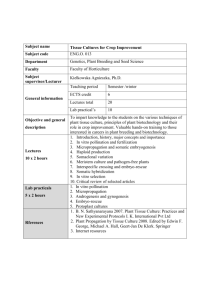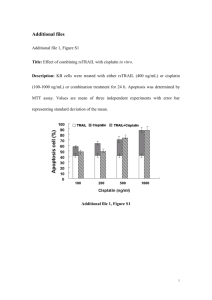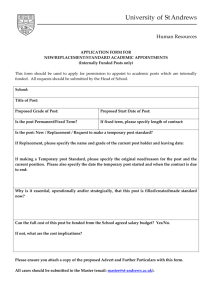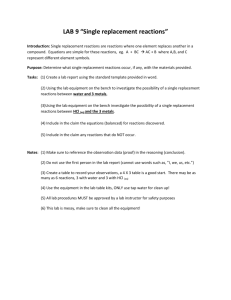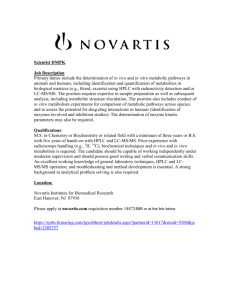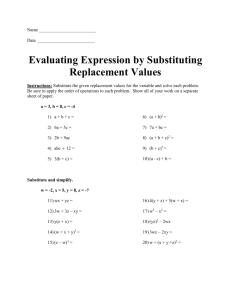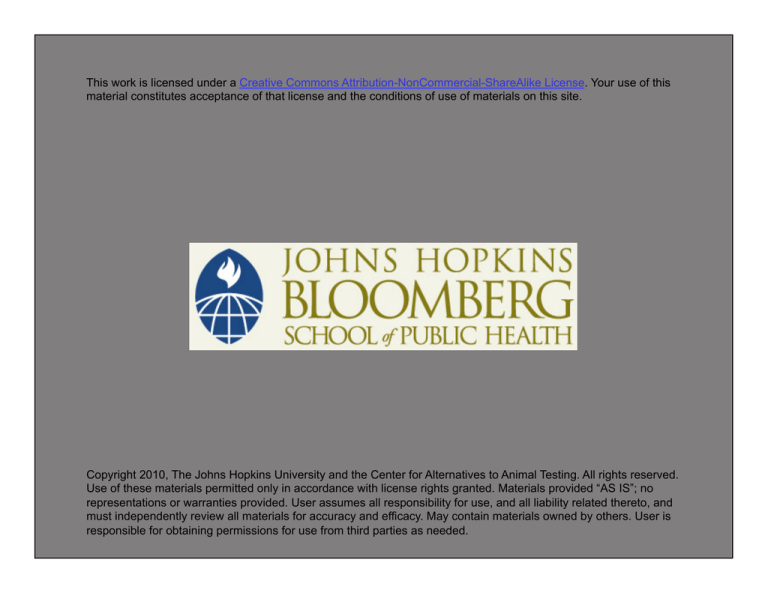
This work is licensed under a Creative Commons Attribution-NonCommercial-ShareAlike License. Your use of this
material constitutes acceptance of that license and the conditions of use of materials on this site.
Copyright 2010, The Johns Hopkins University and the Center for Alternatives to Animal Testing. All rights reserved.
Use of these materials permitted only in accordance with license rights granted. Materials provided “AS IS”; no
representations or warranties provided. User assumes all responsibility for use, and all liability related thereto, and
must independently review all materials for accuracy and efficacy. May contain materials owned by others. User is
responsible for obtaining permissions for use from third parties as needed.
Replacement
Enhancing Humane Science
Alan M. Goldberg & James Yager
Replacement
Replacement – the word that all confuse with
alternatives – alternatives are all 3Rs – Reduction,
Refinement and Replacement
Reduction
Reduction – addresses the issue of experimental
design and evaluation; it is not just less animals (see
Lecture 12 by Broman)
Refinement
Refinement – the concept is to eliminate and/or reduce
any potential pain and distress to a minimum (see
Lecture 10 by Gabrielson)
Replacement
Concept of Replacement in:
Basic Science (Academic Activities)
Product Development/Discovery
Regulatory (Scientifically valid vs. validation)
Basic Science
In vitro and other non-animal methods are a routine part
of basic science studies. At most, biology related
meetings (SOT, ASPET, FASEB) in vitro methods
dominate 80% of all papers.
Product
Development/
Discovery
Industry use in vitro and other short-term nonmammalian tests for product development/discovery.
This is the set of tests that companies use to make the
business decision that a product will be developed
and put into regulatory required protocols.
Regulatory Testing
Replacement alternatives that are used in regulatory
testing have been validated by a well defined process
– ICCVAM, USA and ECVAM, EU.
• ICCVAM = Interagency Coordinating Committee on
the Validation of Alternative Methods. For Details see
http://iccvam.niehs.nih.gov/
• ECVAM = European Center for Validation of
Alternative Methods. For details see
http://ecvam.jrc.cec.eu.int/index.htm
Validation: Definition
Determination that a test is reliable and relevant for a
specific purpose
Systems for Testing
In Vivo
Laboratory Animals
In Vitro
Cells and
Tissues
Human
Observations
Structure/Activity
Replacement
• Relative Replacement – an in vitro test that requires
animal tissue.
• Absolute Replacement – human cells in culture,
computer modeling, SAR.
Replacement –
Examples 1
•
•
•
•
•
•
•
Pregnancy Test Kits
Pyrogen
Limulus Test
Cytokine Measurement
Monoclocal Antibodies
Invertebrate Systems – c-elegans
SAR
Computer Modeling
Hormones (Mouse Convulsion
High Performance
Liquid Chromatography)
Replacement –
Examples 2
The following will be discussed on the following slides
• Physiologically Based Pharmokinetic Modeling
(Toxicokinetic)
• Genotoxicity – bacterial mutagenesis assays
• Hormone Assays
• Cells in Culture – Animal/Human
• Reconstituted Tissue Equivalents (Eye Irritation, Skin
Corrosivity Testing)
Physiologically Based
Pharmacokinetic (PBPK)
Modeling (Toxicokinetic)
• Purpose: to mathematically model how a substance
is absorbed, distributed and metabolized in the body
to reduce uncertainties in determining the estimated
dose
• Models are based on experimental data
Genotoxicity
Short-term tests for carcinogen identification –
Gene mutation assays (Casarett & Doull, Chap 8, pp. 292)
Bacterial-Ames Assay
• bacterial assay that examine reverse mutation
Various mammalian cell culture systems
• Mutations
• Damage: DNA, chromosomes, cell transformation
Genotoxicity
In Vitro Tests for Genotoxicity
Mutagenicity in bacteria
Ames Assay: depends on the stability of mutagenic
chemicals to bring about reverse mutaions in mutant strains
of Salmonella typhimurium
basis of assay: mutation in histidine biosynthesis
pathway: bacteria require histidine for growth, cannot
grow in absence of histidine
protocol
S-9 (subcellular fractions containing microsomes)
Tester strains
+ controls
Insulin
• Mouse convulsion assay to HPLC
Total Replacement
http://caat.jhsph.edu/pubs/newsletter/news_win88/
insulin.htm for story (CAAT Newsletter)
Anti-Cancer Agent
Screening
• Mouse
human cells in culture
Barrier Properties of
Reconstituted Human
Epidermis
reconstituted human epidermis, lifted from the plastic
insert after dispase II treatment for 3 minutes at room
temperature.
Tissue Culture Insert
Principle
In vivo
Reconstituted in vitro
In Vitro Testing Approach
• Multiple endpoint analysis
Topical application of test product
Three different assay types are used
• Tissue viability
• Histology
• Chemical profile
Advantages of In
Vitro Systems
• Reduced cost
• Reduction in animal use
• Greater experimental control over chemical
concentrations, environmental composition
• Uniform biological systems (cell lines)
• Ability to use human tissue/cells
Major Disadvantages of
In Vitro Systems
•
•
•
•
Loss of organ structure & cell-cell interaction
Loss of differentiated tissue/cell-specific function
Short-term
Static regarding nutrient influx, metabolite
accumulation
Conclusions
• Although the method of choice and routine in basic
science, in vitro, cell culture and other replacement
alternatives are usually not identified as a
replacement alternative.
Conclusions
• In vitro and other replacement alternatives are used
by industry – they determine scientific validity and are
used for discovery and development. They use these
methods and make business decisions
Conclusions
• Regulatory – generally want validation study
• See ICCVAM and/or ECVAM for process
Conclusions
• Getting to in vitro does not mean no animal testing
Conclusions
• A major contribution of all scientists in this field is to
provide fully characterized in vitro, cell culture, and
other alternatives that can be used to elucidate basic
mechanisms of biology and toxicology and provide
predictive answers for safety evaluation
Study Questions
• Discuss ways that in vitro and other replacement
methodologies can improve the research activities
you are involved in.
• In Vitro and in silico methods can provide mechanistic
understanding of how chemical/drugs change
biological function. Explain how this knowledge
advances our knowledge of disease and health.

